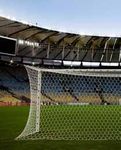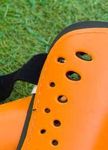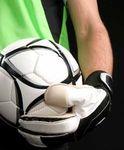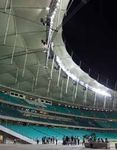World Cup 2014 The football standards - NEN sets the standard
←
→
Page content transcription
If your browser does not render page correctly, please read the page content below
World Cup football, standards around the field
Time is running out for preparations in Brazil, venues or airports may not be “totally ready” for the 2014
World Cup. However, the tournament kicks off on June 12. As always, it unleashes a lot of emotion all
over the world. The Dutch will nervously follow their first match against defending World Champion Spain!
Will we make it to the finals? Will we be World Champion for in making agreements about safety, quality and service
the first time in history? It’s no easy undertaking, our group levels. We don’t always see these standards, but they are
stage is a huge challenge! there, to make your life easier and safer on a daily basis.
And when it comes to football, it needs to be a fair and safe
But did you know that it is also quite a challenge to make game! That’s why there are requirements for the goal, the
sure a tournament like the World Cup football is safe for both ball, the seats in stadiums, and even for beer! To get to know
players and fans? People from all over the world participate these standards, we present you a squad of eleven!
Brazuca
“The brazuca weighs 437 grams.”
Spain opens their title defence on June 13 in Salvador against the Dutch. They defeated us in
South Africa so it’s time to set things straight. But after Spain scores the Dutch are thrown back
for a while. Towards the end it is still 1-0. Spain is holding up their defense and Robben kicks the
ball with enormous force towards the Dutch goal. While Cillessen charges out of his goal, the ball
bounces on the edge of the penalty area. He is astonished to watch the ball bounce high over his
head into his empty goal... Can this really happen? No, Brazuca far exceeds the “FIFA Approved
Standards”. In addition, the standard EN 12235 sets requirements and test methods for the ball.
For example the bounce behaviour, if it is dropped from a height of 2 metres onto a concrete sur-
face, after the bounce it should rise again by 1.35 metres. So the ball never bounces back over our
hero. With 3 minutes to go, he kicks the ball to attacker Van Persie. Now is the time! And yes, Van
Persie runs, shoots and it ‘s a goalllllll! The Dutch go crazy, just in time, our first point in Group B!
Stadium seats
“2.5 million centimetres of red chairs.”
On June 18, we play our second match against Australia in Porto Alegre. We must win this
one! Tens of thousands of spectators flood the stadium. Everyone shuffles along to find their
seat. The late arrivals push their way past the grumbling fans who have already taken their
places. The space to the seat in the row in front is, according to the standard EN 13200-4
at least 30 cm. Not ideal, but so what, all that counts now is the match. The “Orange Army”
sings, shouts and jumps up on the seats. But what requirements must the seats actually
meet? According to the requirements in the standard, a stadium seat should be able to bear
a weight of 2000 kg. The seat is a minimum of 40 cm deep and 50 cm wide. The Beira-Rio
stadium in Porto Alegre has a capacity of 50,000 seats. That is is 2.5 million cm of chairs all
around! Hopefully on at least half of those orange coloured fans are seated!
NEN World Cup 2014, the football standardsGrass
“Everyone seems to have an opinion about the pitch.”
We don’t see any artificial grass in the Brazilian stadiums. It is either the grass species “Bermuda
Celebration” or “Ryegrass”. The height of the grass often leads to discussion, but oddly enough,
there are no requirements for it. According to experts, the height is preferably 23 mm. But how
do they measure this? Does our coach Van Gaal has a ruler in his pocket to measure the height
before kick-off? Maybe, but it would be better to use the test method in the European standard
EN 12233. It sets requirements to properly determine the height of the grass. They use a light-
weight device, a round disk attached to a special ruler. The grass height is defined as the ruler
hits the ground and the disk leans on the leaves. Not as convenient as a simple ruler in Van Gaal’s
pocket, but at least that way the measurements are correct. Let’s hope the “Ryegrass” in Sao
Paulo is perfect, so Van Gaal only has to focus on winning the match against Chile on June 23!
Assured of a safe beer
“Substances of fungi in your beer?”
Whether with friends at home, in the pub or in a town square, watching football often goes hand in
hand with a glass of beer. During events it is common to be served beer with a lower alcohol content,
usually in plastic cups. This “event-beer” promotes safety. And it contains up to 50% fewer calories than
regular beer, nice bonus! But the beer itself must also be safe to drink. What is actually in it? It is well
known that it contains mainly water, malt, sugar and hops. But substances of fungi? In beer there is
also a matter that should be handled carefully, ochratoxin A (OTA). This is produced by fungi and occurs
in a variety of plants and products. The permitted amount of ochratoxin in wine and beer is determined
by law. Beer brewers can measure it by the test method in the standard EN 14133. Cheers!
Gloves
“Without good gloves even Cillessen is in trouble.”
Runner up in Group B, the Dutch team hasn’t had the best start this tournament. On June 28
we will play against the winner in Group A, Brazil! Yet another challenging opponent! If defenders
Vlaar and Blind can’t prevent Neymar heading into the direction of our goal, our goalkeeper
Cillessen is the last line of defense! Everyone in the Netherlands relies on his skills! He has a
rapid response but that’s not enough. He needs good gloves as well! Good gloves meet the
requirements of EN 16027. According to this standard, the gloves may shift no more than 20
mm. It may never slip off the hands. And did you know goalkeeping gloves should be worn
slightly larger than hand size? This provides increased ball blocking ability and grip.
NEN World Cup 2014, the football standardsShin pad
“A kick on the shins shouldn’t cause more than a bruise”
82 minutes into the second round against Brazil in Wesley Sneijder has free play. His path to the
Brazilian goal is only blocked by defender Alves. It’s 1-0 and the Dutch set out to score in the second
half of the match. We’re not just in to win this match, we need a greater number of goals! Sneijder
is going at full speed, while Alves comes charging down the midfield. From a metre away he starts his
tackle for the ball. Or is he going for Sneijder? Is his shin-pad strong enough for this confrontation?
If it complies with NEN-EN 13061 Sneijder will only get a bruise. Tests ensure maximum safety. After
a kick the shin-pad should not move more than 15 mm. And the deformation after a kick may not be
more than 25 mm! With the shin-pads of our guys it should be alright. So come on guys, let’s go to the
quarterfinals!
Dutch Home Kit
“Our guys all wear an average of 18 plastic bottles!”
All players in the Dutch selection wear an average of 18 plastic bottles. The shirt, short - and for the first
time in a national team kit, the socks - all feature fabric made from recycled plastic bottles. It’s a beautiful
example of innovation. Plastic bottles that we throw away turned into fabric, that’s why recycling is a good
thing! The label of each garment should tell where it is made of, so does it say 100% plastic bottle? No,
it becomes 100% recycled polyester. To be precise, 100% recycled polyester in the shorts, 96% and
78% in the shirt in the socks. The label should also provide the proper washing instructions. The global
standard NEN-EN-ISO 3758 specifies requirements for the symbols used on the labels. This standard not
only provides consumers worldwide clarity by providing the same symbols all over the world. It is also a
tool for businesses such as laundries and dry cleaners. Being able to choose the right cleaning or drying,
no matter which country it’s made in, ensures your garment last longer!
Goal
“The maximum mesh size of the net is 12 centimetres.”
32 minutes into the quarter-final against Italy De Rossi takes a corner kick. He shoots the ball really
hard in the direction of the goal and to everyone’s amazement, the ball tears the net and lands into
the goal! Can Italy really take the lead this way? No, luckily there is a standard for the goal, NEN-EN
748. This standard provides specifications for the the twine, the mesh size, the goal posts and off
course the dimensions of the goal. The twine must have a minimum diameter of 2mm and the maxi-
mum mesh size is 120mm. And the dimensions should be 7.32 by 2.44 metres. Good to know that
the posts and cross-bar should only bend 1 cm if the ball hits it. So that’s alright then!
NEN World Cup 2014, the football standardsSustainable stadiums
“Stadiums are increasingly sustainable constructions.”
Unbelievable, the Dutch play the semi-final against Germany! The roof is on fire! Well not literally of
course, but this football rivalry is one of the few longstanding football rivalries. However, if the solar
panels on the roof of the stadium in Belo Horizonte are not installed according to safety standards,
fire may break out because of a short circuit. If all is done well, the roof converts sunlight into electri-
city. It is one of the many sustainable and innovative solutions we see during this World Cup. Another
one is the roof of the new stadium in Salvador. It can collect about 698,000 liters of rainwater for
reuse. Existing roofing standards ensure a good and safe construction. In addition, more and more
standards for sustainable constructions are under development worldwide!
Lighting
“Good lighting is indispensable for a cameraman.”
It seemed impossible, but we have made it to the finals! On July 13, we compete against Argentina for
the World Cup. Glued to the TV we anxiously watch the minutes pass by, we are so close now! Surrounding
the field are dozens of cameras. We want to see everything! So it is important that all cameras can capture
every inch of the pitch. Every detail counts, so the lighting has to be perfect. But what is perfect? Experts
have set out requirements for how to light a pitch in the European standard EN 12193 for sports lighting. It also
includes requirements for the lighting for television recordings. According to the standard, the area around
the field, where the cameras are set up, should be 0.25 times brighter than the field! It does not seem like
much, but do we want to miss one second of this great final?
Orange
“The orange colour in three-dimensional x, y, and z values?”
We are world champions, for the first time in history! It is almost impossible to grasp, we made it! The
Netherlands has never looked this orange. People, cars and even houses are painted orange. City
squares filled with fans dressed in orange. The flag is out everywhere, with orange pennant! But what
is the “right” color orange? How is that color determined? Since 1958 there has been a standard for
this, NEN 3203. One of the oldest standards that is still in force! It sets the official colour in chromati-
city coordinates. Quite mathematical, but for the experts among us: this standard can be downloaded
for free at www.nen.nl/wk2014. So go and check out the three-dimensional x, y, and z values!
Want to learn more about NEN, standards and participating?
Contact us or check out our website www.nen.nl. Available in English in June 2014!
NEN World Cup 2014, the football standardsNEN Communications P.O. Box 5059 2600 GB Delft Vlinderweg 6 2623 AX Delft T + 31 15 2 690 390 info@nen.nl www.nen.nl © NEN May 2014 NEN sets the standard
You can also read



























































